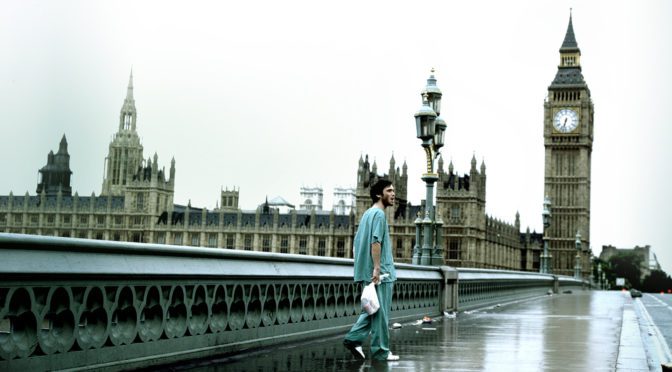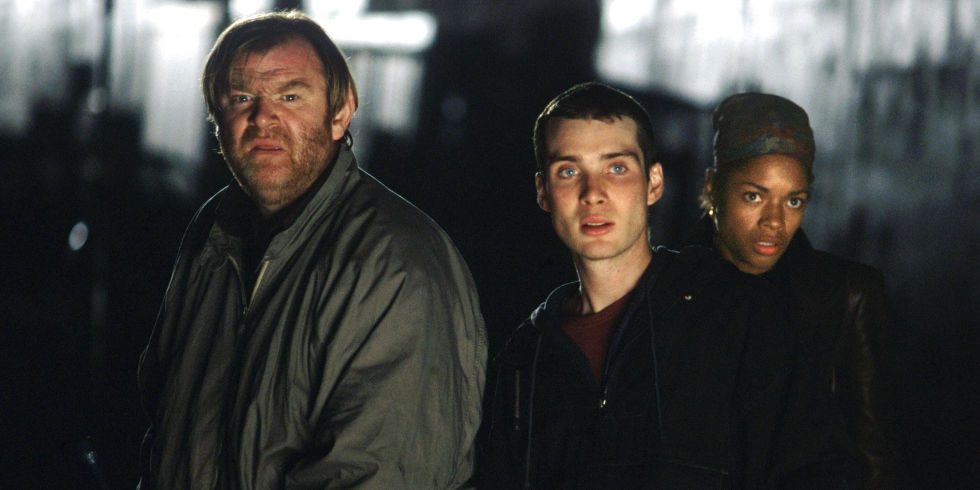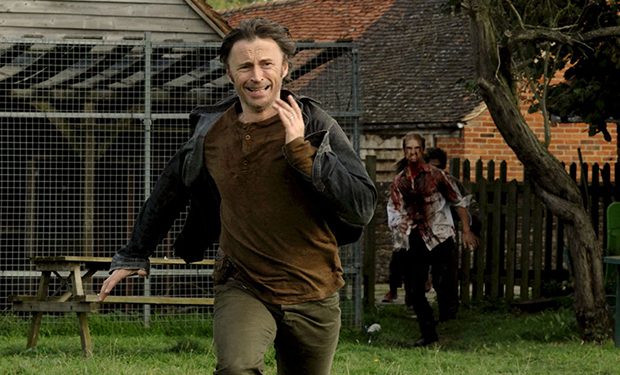“Plans are pointless.”
The zombie genre was dead and buried by the time Danny Boyle’s 28 Days Later hit theaters in November 2002. The genre was represented poorly: a few months prior to this film’s release, the first wretched Resident Evil movie stumbled onto screens, and the only option that gamers had was Return to Castle Wolfenstein. Now zombies have pretty well permeated the culture; you can sit down to play Left 4 Dead or Dead Island in between reruns of The Walking Dead or before you pop in a DVD of Maggie, Life After Beth, or Warm Bodies, or even before listening to the podcast We’re Alive. Boyle’s film breathed new life into the genre (god, it’s hard to resist life and death puns), and while we’ve long since reached the point of oversaturation, 28 Days Later remains a vital entry in the canon. It remains, along with Shaun of the Dead, one of the last films in which someone tried to do something different with zombies.
The zombies here are fast and animalistic. (And yes, I know technically they’re infected humans, but you can shove your semantics up your ass because I know a goddamn zombie when I see one.) Boyle and his cinematographer Anthony Dod Mantle (who won as Oscar for shooting Boyle’s Slumdog Millionaire) utilize handheld cameras to give 28 Days Later a sense of urgency that replicates the immediacy of a documentary. This is exactly why everyone uses handheld cameras, but it rarely works. But here it’s tense and visceral, and almost evokes a sense of panic, no more so than when Jim (Cillian Murphy) flees from a group of flaming zombies. The film is wonderfully edited, too, by Chris Gill, who makes all the blurry, frenetic action somehow easy to follow.
What surprised me about this film while re-watching it was the amount of time Boyle spends away from zombies. When Jim and Selena (Naomie Harris, tough, charismatic, and beautiful) group up with Frank (Brendan Gleeson) and his daughter Hannah (Megan Burns), the zombies fade into the background of the film while the group bonds. It’s here, before the horrific climax, that 28 Days Later reveals itself as a story about family, and moving on together. The film’s middle third is akin to a road-trip movie, and Boyle allows us to luxuriate in the sights of rural England, summed up nicely by an unapologetically beautiful shot of wild horses running through the hills. It is this beauty that makes Frank’s infection so sad, infuriating, and arbitrary, just like death itself.
I wouldn’t call 28 Days Later a film with an outright pacifist message, but it does speak about the danger of letting your rage control you. Hell, the virus that sweeps through the country is even called “rage.” When Jim returns to the country mansion where Selena and Hannah are being held by Army Major Henry West (Christopher Eccleston), who has promised the women to his men, his rampage is hard to watch, but it’s also the closest thing to catharsis that Boyle allows us. He doesn’t beat us over the head with “maybe the humans were the real monsters,” because he doesn’t need to. 28 Days Later is hopeful in a sly way, in the face of ugliness.
Through Frank, Hannah, Selena, and Jim, the film argues that people are people, no matter the circumstances. The good will remain good, the bad will get worse. The world might get uglier, but it’s unlikely to change too much (the film ends with Jim, Selena, and Hannah trying to catch the attention of a fighter jet, suggesting a quick return to something like normalcy). This can be comforting, or it can be scary, but it still is. Like the title indicates, time just passes.
28 Weeks Later is arguably an unnecessary sequel, but it acquits itself nicely nonetheless. Juan Carlos Fresnadillo’s film operates on a bigger scope than does 28 Days Later, but it can never quite decide which character it wants to follow, and the result can get pretty frustrating.
Which is too bad, because the film gets off to an impressive start, with Don (Robert Carlyle, the only watchable part of Once Upon a Time) abandoning his wife to die in the middle of an attack by the infected. It’s an act of unspeakable cowardice and selfishness, and the film challenges us by treating Don as its ostensible protagonist. It’s a bold move, one that speaks to the bleakness underlying 28 Weeks Later.
The film starts up about seven months after the rage virus outbreak, and things have returned somewhat to normal. An American-led NATO peacekeeping force is in control of a “green zone” in Britain, where survivors are being shipped in to restart and rebuild. This is a good way to broaden the scope of the film, as well as utilize some solid character actors – Jeremy Renner, Rose Byrne, Idris Elba, Imogen Poots, and Harold Perrineau all show up and do a good job (although Elba, one of the few men on earth who actually looks better with a mustache, is given little to do besides scowl).
A big problem with 28 Weeks Later is that it relies too heavily on callbacks to the first film. John Murphy’s “In the House – In a Heartbeat,” the music that played during Jim’s rampage, appears no less than three times in Weeks, and the film makes the mistake of having another character gouge out someone’s eyes with their thumbs; it felt earned in the first film, but merely gratuitous here. 28 Weeks Later should have focused on its own story, but it does potentially dovetail nicely with Danny Boyle’s film. After Elba orders a “code red” and firebombs the green zone, I found myself wondering if Jim, Selena, and Hannah were among the survivors. It undercuts the daringly hopeful note that 28 Days Later ended on, and it’s audaciously nihilistic.
There’s a difference in quality between Days and Weeks, but Boyle’s and Fresnadillo’s films compliment each other nicely. They show two different sides of a similar end of the world scenario, and come full circle in a satisfactory way, showing hopefulness and despair in equal measure.
10/1: Dawn of the Dead (2004)
10/2: The Exorcist
10/3: Pontypool
10/4: Hocus Pocus
10/5: The Orphanage
10/6: Rosemary’s Baby
10/7: Alien
10/8: Scream series
10/9: Scream series
10/10: Cujo
10/11: The Cabin in the Woods
10/12: Pulse
10/13: The Babadook
10/14: Friday the 13th
10/15: The Last House on the Left (both versions)
10/16: The Thing (both versions)
10/17: Little Shop of Horrors
10/18: Hush
10/19: Silent Hill
10/20: The Shining
10/21: Funny Games (2007)
10/22: Evil Dead series
10/23: Evil Dead series
10/24: The Mist
10/25: The Ninth Gate
10/26: The Fly
10/27: A Nightmare on Elm Street
10/28: The Nightmare Before Christmas
10/29: 28 Days Later/28 Weeks Later
10/30: It
10/31: Halloween (either version)





